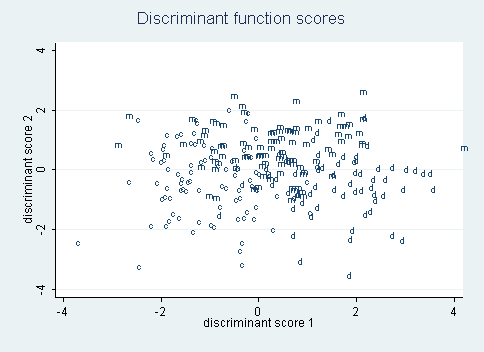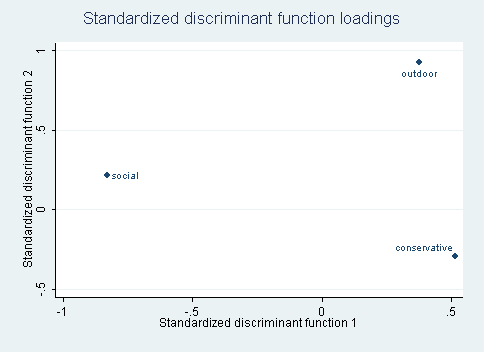Version info: Code for this page was tested in Stata 12.
Linear discriminant function analysis (i.e., discriminant analysis) performs a multivariate test of differences between groups. In addition, discriminant analysis is used to determine the minimum number of dimensions needed to describe these differences. A distinction is sometimes made between descriptive discriminant analysis and predictive discriminant analysis. We will be illustrating predictive discriminant analysis on this page.
Please note: The purpose of this page is to show how to use various data analysis commands. It does not cover all aspects of the research process which researchers are expected to do. In particular, it does not cover data cleaning and checking, verification of assumptions, model diagnostics or potential follow-up analyses.
Examples of discriminant function analysis
Example 1. A large international air carrier has collected data on employees in three different job classifications: 1) customer service personnel, 2) mechanics and 3) dispatchers. The director of Human Resources wants to know if these three job classifications appeal to different personality types. Each employee is administered a battery of psychological test which include measures of interest in outdoor activity, sociability and conservativeness.
Example 2.
There is Fisher’s (1936) classic example of discriminant analysis involving three varieties of iris and four predictor variables (petal width, petal length, sepal width, and sepal length). Fisher not only wanted to determine if the varieties differed significantly on the four continuous variables, but he was also interested in predicting variety classification for unknown individual plants.
Description of the data
Let’s pursue Example 1 from above.
We have a data file, discrim.dta, with 244 observations on four variables. The psychological variables are outdoor interests, social and conservative. The categorical variable is job type with three levels; 1) customer service, 2) mechanic and 3) dispatcher.
Let’s look at the data. It is always a good idea to start with descriptive statistics.
use https://stats.idre.ucla.edu/stat/stata/dae/discrim, clear
summarize outdoor social conservative
Variable | Obs Mean Std. Dev. Min Max
-------------+--------------------------------------------------------
outdoor | 244 15.63934 4.839933 0 28
social | 244 20.67623 5.479262 7 35
conservative | 244 10.59016 3.726789 0 20
tabstat outdoor social conservative, by(job) stat(n mean sd min max) col(stat)
Summary for variables: outdoor social conservative
by categories of: job
job | N mean sd min max
-----------------+--------------------------------------------------
customer service | 85 12.51765 4.648635 0 22
| 85 24.22353 4.335283 12 35
| 85 9.023529 3.143309 2 17
-----------------+--------------------------------------------------
mechanic | 93 18.53763 3.564801 11 28
| 93 21.13978 4.55066 9 29
| 93 10.13978 3.242354 0 17
-----------------+--------------------------------------------------
dispatch | 66 15.57576 4.110252 4 25
| 66 15.45455 3.766989 7 26
| 66 13.24242 3.69224 4 20
-----------------+--------------------------------------------------
Total | 244 15.63934 4.839933 0 28
| 244 20.67623 5.479262 7 35
| 244 10.59016 3.726789 0 20
--------------------------------------------------------------------
correlate outdoor social conservative
(obs=244)
| outdoor social conser~e
-------------+---------------------------
outdoor | 1.0000
social | -0.0713 1.0000
conservative | 0.0794 -0.2359 1.0000
tabulate job
job | Freq. Percent Cum.
-----------------+-----------------------------------
customer service | 85 34.84 34.84
mechanic | 93 38.11 72.95
dispatch | 66 27.05 100.00
-----------------+-----------------------------------
Total | 244 100.00
Analysis methods you might consider
Below is a list of some analysis methods you may have encountered. Some of the methods listed are quite reasonable, while others have either fallen out of favor or have limitations.
- Discriminant function analysis – The focus of this page. This procedure is multivariate and also provides information on the individual dimensions.
- Multinomial logistic regression or multinomial probit – These are also viable options.
- MANOVA – The tests of significance are the same as for discriminant function analysis, but MANOVA gives no information on the individual dimensions. However, the psychological variables will be the dependent variables and job type the independent variable.
- Separate one-way ANOVAs – You could analyze these data using separate one-way ANOVAs for each psychological variable. The separate ANOVAs will not produce multivariate results and do not report information concerning dimensionality. Again, the designation of independent and dependent variables is reversed as in MANOVA.
Discriminant function analysis
We will run the discriminant analysis using the candisc procedure. We could also have run the discrim lda command to get the same analysis with slightly different output. There is a great deal of output, so we will comment at various places along the way.
candisc outdoor social conservative, group(job)
Canonical linear discriminant analysis
| | Like-
| Canon. Eigen- Variance | lihood
Fcn | Corr. value Prop. Cumul. | Ratio F df1 df2 Prob>F
----+---------------------------------+------------------------------------
1 | 0.7207 1.08053 0.7712 0.7712 | 0.3640 52.382 6 478 0.0000 e
2 | 0.4927 .320504 0.2288 1.0000 | 0.7573 38.46 2 240 0.0000 e
---------------------------------------------------------------------------
Ho: this and smaller canon. corr. are zero; e = exact F
- The number of discriminant dimensions is the number of groups minus 1. However, some discriminant dimensions may not be statistically significant.
- In this example, there are two discriminant dimensions, both of which are statistically significant. The first F-ratio tests that both canonical correlations are zero; the second F-ratio test that only the second canonical correlation is zero. Since both of these tests are significant, it follows that both dimensions are significant and are needed to describe the differences between the three groups of employees.
- The canonical correlations for the dimensions one and two are 0.72 and 0.49, respectively.
Standardized canonical discriminant function coefficients
| function1 function2
-------------+----------------------
outdoor | .3785725 .9261104
social | -.8306986 .2128593
conservative | .5171682 -.2914406
Canonical structure
| function1 function2
-------------+----------------------
outdoor | .3230982 .9372155
social | -.7653907 .2660298
conservative | .467691 -.2587426
-
- The standardized discriminant coefficients function in a manner analogous to standardized regression coefficients in OLS regression. For example, a one standard deviation increase on the outdoor variable will result in a .3786 standard deviation increase in the predicted values on discriminant function 1.
- The canonical structure, also known as canonical loading or discriminant loadings, represent correlations between observed variables and the unobserved discriminant functions (dimensions). The discriminant functions are a kind of latent variable and the correlations are loadings analogous to factor loadings.
Group means on canonical variables
| job
--------+------------------
group1 | customer service
group2 | mechanic
group3 | dispatch
| function1 function2
-------------+----------------------
group1 | -1.2191 -.3890039
group2 | .1067246 .7145704
group3 | 1.419669 -.5059049
Resubstitution classification summary
+---------+
| Key |
|---------|
| Number |
| Percent |
+---------+
| Classified
True | group1 group2 group3 | Total
-------------+------------------------+-------
group1 | 70 11 4 | 85
| 82.35 12.94 4.71 | 100.00
| |
group2 | 16 62 15 | 93
| 17.20 66.67 16.13 | 100.00
| |
group3 | 3 12 51 | 66
| 4.55 18.18 77.27 | 100.00
-------------+------------------------+-------
Total | 89 85 70 | 244
| 36.48 34.84 28.69 | 100.00
| |
Priors | 0.3333 0.3333 0.3333 |
The output includes the means on the discriminant functions for each of the three groups and a classification table. Values in the diagonal of the classification table reflect the correct classification of individuals into groups based on their scores on the discriminant dimensions.
By default, Stata assumes a priori an equal number of people in each job. This is represented by the 0.3333 Priors in the table above. If you have different expected proportions in mind, you may specify them with the priors option.
Next, we will plot a graph of individuals on the discriminant dimensions. Due to the large number of subjects we will shorten the labels for the job groups to make the graph more legible. As long as we do not save the dataset, these new labels will not be made permanent.
label define job 1 "c" 2 "m" 3 "d", modify scoreplot, msymbol(i)
The discrimant functions are:
discriminant_score_1 = 0.517*conservative + 0.379*outdoor – 0.831*social.
discriminant_score_2 = 0.926*outdoor + 0.213*social – 0.291*conservative.
As you can see, the customer service employees tend to be at the more social (negative) end of dimension 1; the dispatchers are at the opposite end; the mechanics are in the middle. On dimension 2 the results are not as clear; however, the mechanics tend to be higher on the outdoor dimension and customer service employees and dispatchers are lower.
We can also plot the discriminant loadings for the variables onto the discriminant dimensions.
loadingplot
There is no surprise that the variable social is strong on the social dimension, i.e., it has a high negative loading, and the outdoor variable is high on the outdoor dimension.
Things to consider
- Multivariate normal distribution assumptions holds for the response variables. This means that each of the dependent variables is normally distributed within groups, that any linear combination of the dependent variables is normally distributed, and that all subsets of the variables must be multivariate normal.
- Each group must have a sufficiently large number of cases.
- Different classification methods may be used depending on whether the variance-covariance matrices are equal (or very similar) across groups.
- Non-parametric discriminant function analysis, called kth nearest neighbor, can also be performed.
See also
References
- Grimm, L. G. and Yarnold, P. R. (editors). (1995). Reading and Understanding Multivariate Statistics. Washington, D.C.: American Psychological Association.
- Huberty, C. J. and Olejnik, S. (2006). Applied MANOVA and Discriminant Analysis, Second Edition. Hoboken, New Jersey: John Wiley and Sons, Inc.
- Stevens, J. P. (2002). Applied Multivariate Statistics for the Social Sciences, Fourth Edition. Mahwah, New Jersey: Lawrence Erlbaum Associates, Inc.
- Tatsuoka, M. M. (1971). Multivariate Analysis: Techniques for Educational and Psychological Research. New York: John Wiley and Sons.


